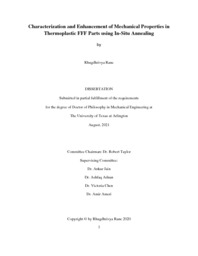
ATTENTION: The works hosted here are being migrated to a new repository that will consolidate resources, improve discoverability, and better show UTA's research impact on the global community. We will update authors as the migration progresses. Please see MavMatrix for more information.
Show simple item record
| dc.contributor.advisor | Taylor, Robert M | |
| dc.creator | Rane, Rhugdhrivya | |
| dc.date.accessioned | 2022-08-30T15:09:51Z | |
| dc.date.available | 2022-08-30T15:09:51Z | |
| dc.date.created | 2021-08 | |
| dc.date.issued | 2021-08-13 | |
| dc.date.submitted | August 2021 | |
| dc.identifier.uri | http://hdl.handle.net/10106/30920 | |
| dc.description.abstract | Fused filament fabrication is one of the most common and widely used additive manufacturing techniques. Owing to its ease of use, availability and cheap feedstock it provides a significant advantage over other AM techniques. But these advantages are overshadowed by the fact that FFF parts show high anisotropy and reduced mechanical properties as compared to conventional manufacturing techniques. Literature review of previous research works show multiple approaches to enhance the mechanical properties of FFF parts but each of these techniques have limitations to either the geometries that can be printed or involve complex expensive setups. In one such technique a metal block is used to apply a thermal field to the part as it is being printed thus improving the interlaminar bonds and eventually the mechanical properties of the parts. Though cost effective and simple a major limitation on this technique is that the exposure of the parts to the thermal field cannot be controlled and has not been optimized. Also, tall and slender parts cannot be printed due to the lack of a cooling mechanism for the upper sections of the filament. Another limitation is that of polymer melt leakage around the nozzle which further makes it difficult to change the nozzle assembly once the block has cooled down. In this project an optimized print head assembly has been developed to improve the mechanical properties of FFF parts which addresses the limitations of the previous works while optimizing the mass of the block and other process parameters to provide maximum enhancement of mechanical properties while reducing geometric distortions. A design of experiments approach has been used to identify the main effects and interaction effects between the two factors (Plate thickness and nozzle height) with three levels each for three response variables (increase in UTS, increase in toughness, increase in fracture toughness). The DOE shows that the nozzle height and plate thickness main effects are present for all three response variables. The factor effects on the mechanical properties have further been explained with the help of a finite volume simulation model for the different levels of testing. A cooling mechanism has been provided to the upper sections of the print head to prevent premature filament softening, also a steady state simulation has been conducted along with relevant experiments to check the efficacy of the cooling mechanism. Parts printed with the optimized print head show good correlation with the DOE analysis with major improvements in ultimate tensile strength, toughness, fracture toughness and stiffness of the FFF parts. A study of the mesostructure of these parts show a change in the void shape from a diamond to circular indicating that these voids now behave more as stress concentration zones rather than failure initiation points. | |
| dc.format.mimetype | application/pdf | |
| dc.language.iso | en_US | |
| dc.subject | Fused filament fabrication | |
| dc.subject | Thermal annealing | |
| dc.subject | Additive manufacturing | |
| dc.subject | Polymer | |
| dc.title | CHARACTERIZATION AND ENHANCEMENT OF MECHANICAL PROPERTIES IN THERMOPLASTIC FFF PARTS USING IN-SITU ANNEALING | |
| dc.type | Thesis | |
| dc.degree.department | Mechanical and Aerospace Engineering | |
| dc.degree.name | Doctor of Philosophy in Mechanical Engineering | |
| dc.date.updated | 2022-08-30T15:09:51Z | |
| thesis.degree.department | Mechanical and Aerospace Engineering | |
| thesis.degree.grantor | The University of Texas at Arlington | |
| thesis.degree.level | Doctoral | |
| thesis.degree.name | Doctor of Philosophy in Mechanical Engineering | |
| dc.type.material | text | |
Files in this item
- Name:
- RANE-DISSERTATION-2021.pdf
- Size:
- 2.660Mb
- Format:
- PDF
This item appears in the following Collection(s)
Show simple item record


